Plextor M9Pe SSD Review
Why you can trust Tom's Hardware
512GB Class Performance Testing
Comparison Products
The Plextor M9Pe faces an even tougher challenge in the 512GB class. There are only a few 1TB products with the Phison E7 and SMI SM2260 controllers, but that group more than doubles in this class. Many companies also became more aggressive in this capacity class with competitive pricing in the latter half of 2017. The Plextor M8Pe 512GB at $268 isn't bad, but it's very close to the $299 Samsung 960 Pro.
Speaking of the market leader, we've finally tested the 960 Pro 512GB and included it in the charts. It joins the M8Pe add-in card and Corsair NX500 400GB in the upper pricing tier. The MyDigitalSSD BPX and Intel 600p make up the lower end of the pricing scale. The Toshiba RD400 with 15nm planar TLC straddles the middle with mainstream performance at a premium price.
Sequential Read Performance
To read about our storage tests in-depth, please check out How We Test HDDs And SSDs. We cover four-corner testing on page six of our How We Test guide.


The 960 Pro takes an easy lead. The two new Plextor drives reach peak performance at QD8 and are the closest to the 960 Pro, but we see similar performance from several other drives at lower queue depths.
Sequential Write Performance


The heatsink didn't help the M9Pe during our sequential write test. The drives idle for twenty seconds between each pass of our new synthetic burst test but that still wasn't enough time for the M9Pe to recover.
Again, we see a very small SLC cache, or as Plextor calls it: PlexNitro. The native TLC sequential write speed hovers around 500 MB/s. The 256GB M9Pe has 16 die spread across two packages, while the 1TB drive employs 32 die in four packages. It's difficult to tell on the line chart, but the 512GB should have half the SLC cache capacity of the larger model. Sequential write throughput drops to a lower level of performance after you saturate the SLC cache. The 512GB at 500MB/s of throughput is still faster than premium SATA products, but it's much slower than the 1TB's 750MB/s.
Random Read Performance

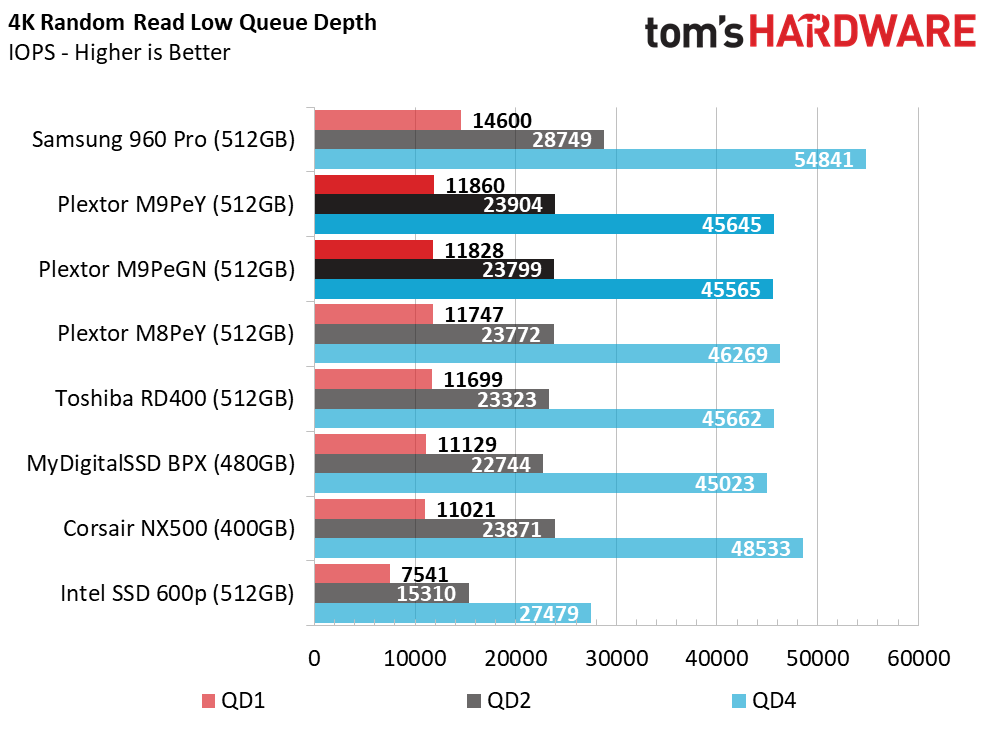

The mid-size M9Pe SSDs lose 800 IOPS compared to the 1TB model, but they are still competitive at low queue depths. Aside from the 960 Pro and Intel 600p, most of the drives offer similar performance in this test. Only 800 IOPS separates the mid-range at QD1.
Get Tom's Hardware's best news and in-depth reviews, straight to your inbox.
Random Write Performance


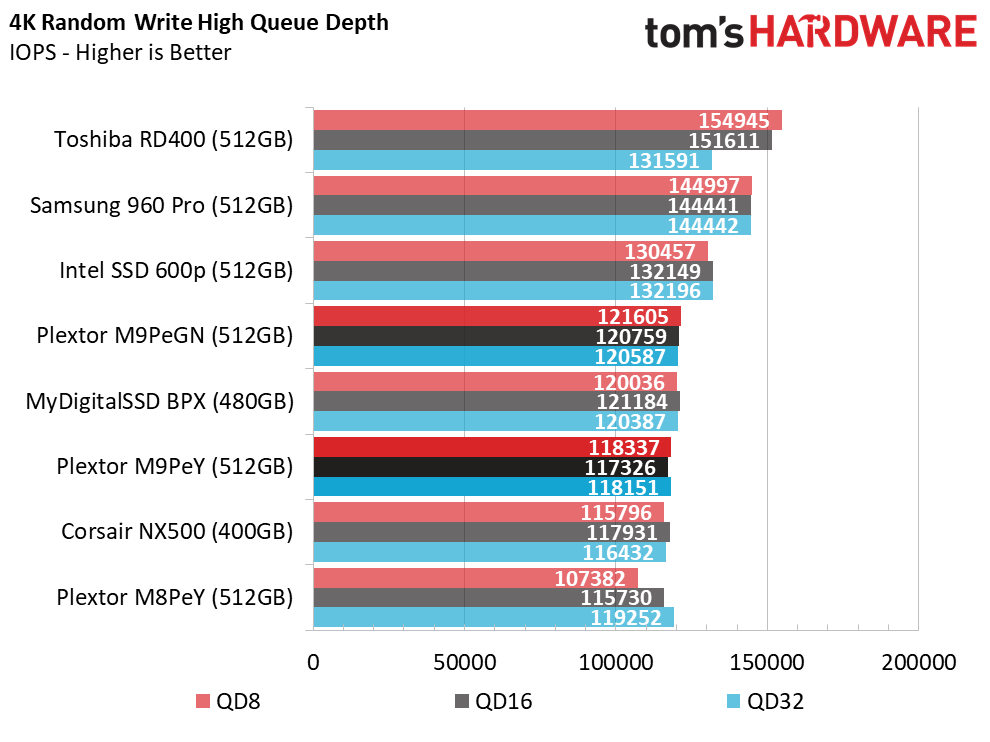
We often breeze by random write performance due to the strength of modern SLC programming. We use this test to look for weak performance that may cause issues during the mixed random workloads. The M9Pe's SLC cache may be small, but it's large enough to tackle consumer-class random write workloads.
70% Mixed Sequential Workload
We describe our mixed workload testing in detail here and describe our steady state tests here.
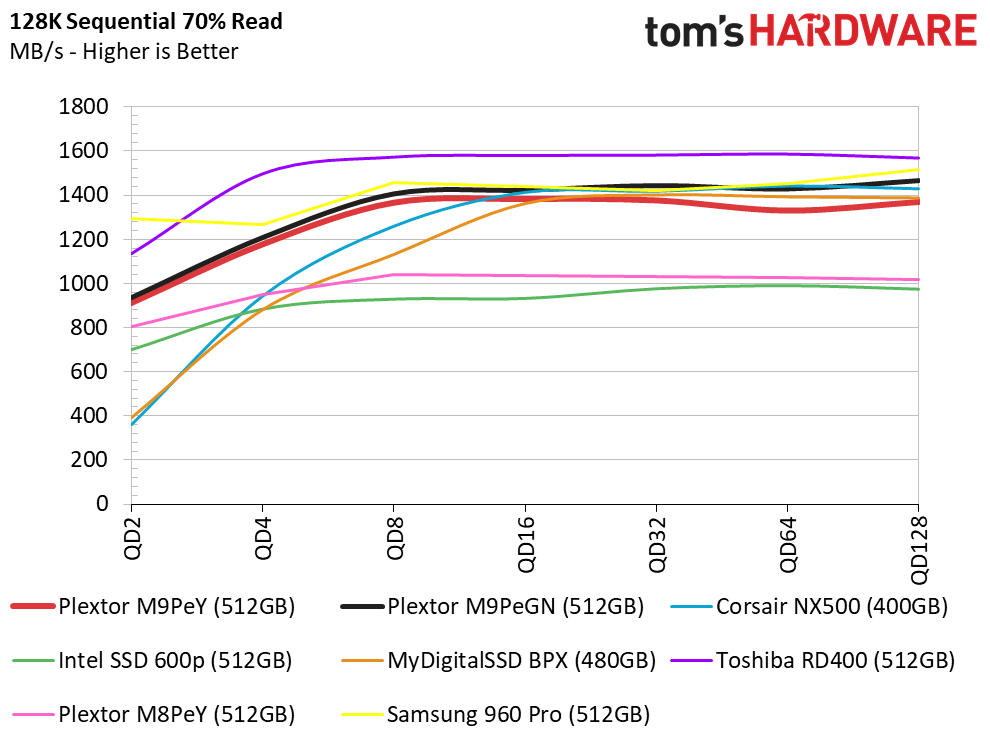

The new Toshiba BiCS Flash is impressive in the new Plextor NVMe SSDs, but the RD400 and 960 Pro take the top spot. Considering their TLC NAND, the M9Pe drives are impressive at QD2.
70% Mixed Random Workload


The competition is thick here. All but two of the products cluster together at low queue depths, so typical application performance on a desktop should net users roughly the same results. We'll turn our attention to applications after we examine heavy-use conditions.
Sequential Steady-State

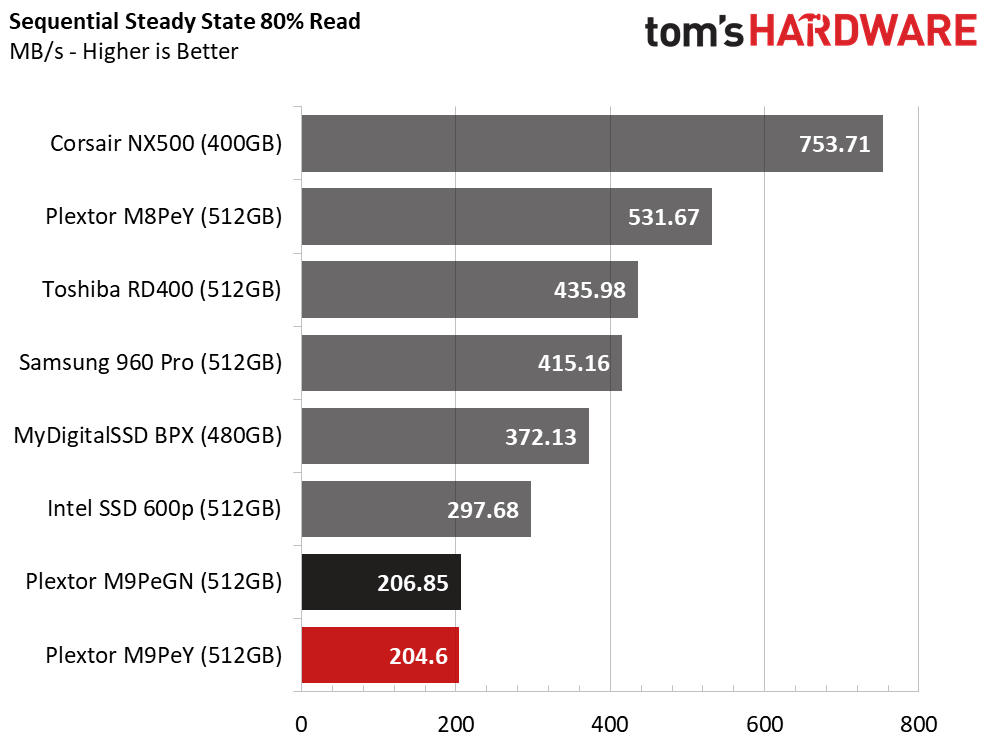

Sequential steady-state performance is even lower in this capacity class. The M9Pe joins the Intel 600p during the write-heavy portion of the test (right-hand side of the line chart). The M9Pe's read performance is slightly better than the 600p but neither drive should be considered a serious workstation contender.
Random Steady-State


The M9Pe provides a consistent 15,000 IOPS, or ~5,000 less than the M8Pe, during the steady-state test. If prices decline, which we expect in early 2018, you may want to use two M9Pe 512GB drives in RAID 0. The M9Pe's consistent performance makes that a viable option.
PCMark 8 Real-World Software Performance
For details on our real-world software performance testing, please click here.




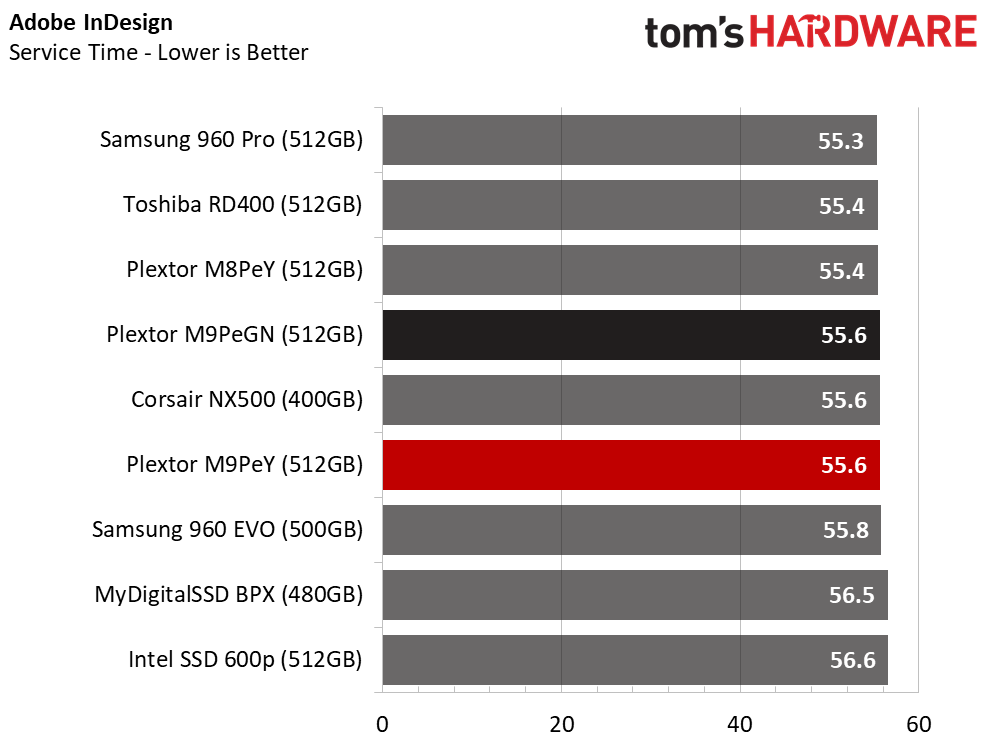


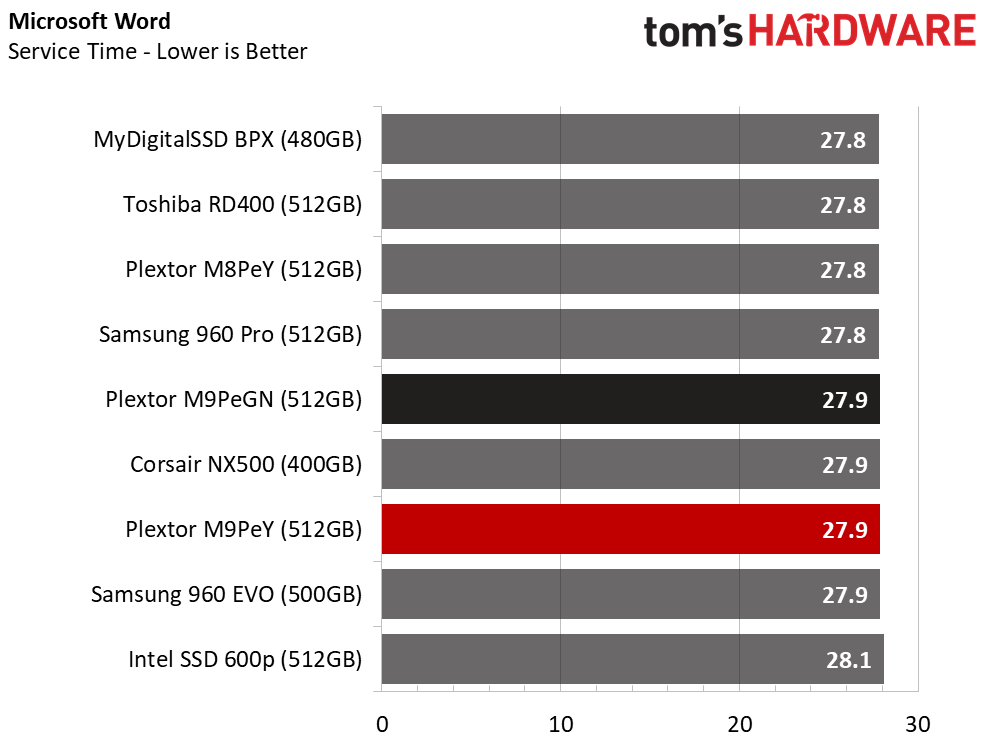


Many of these drives perform nearly the same with common applications, so pricing and strengths in other areas become the differentiators. MLC NAND still delivers the highest consistency if you work with a lot of large files and move them around frequently, but TLC drives can close the gap with large SLC caches. High random performance is still the best attribute to look for, though.
Application Storage Bandwidth
Just like in the 1TB class, the new M9Pe SSDs will contend with the older M8Pe drives that are still on the market. They are faster and more consistent. The results tell us the M8Pe, released back in 2016, is the better NVMe SSD. Plextor doesn't have the option of producing that model, though, because the flash is end of life.
PCMark 8 Advanced Workload Performance
To learn how we test advanced workload performance, please click here.



The PCMark 8 Extended Storage Tests show us how the random steady-state results and SLC cache tests relate to real-world use. The two M9Pe SSDs deliver consistent performance between the heavy and recovery stages. A larger SLC buffer and more processing power could boost performance during the recovery portion of the test.
Total Service Time



The M9Pe doesn't recover even after the five minutes of idle time between each phase of the test. If you write a lot of data to the new Plextor drives it will take a long time for the background garbage collection to restore performance.
The laggardly recovery time could be a concern when you first build a new PC or copy a large amount of data to the drive. For most of us, the early setup process is the most intensive time the drive will ever experience. That's because you install the operating system, drivers, and a slew of applications in the span of a few hours.
Disk Busy Time
The two M9Pe drives work harder and longer than most of the others in this group. Even the 600p can get its latency under control during the recovery stages, but that doesn't happen with the Plextor SSDs.
BAPCo SYSmark 2014 SE Responsiveness Test


These two tests are also the last of our lab sequence. First, we run the drives run through a cleaning cycle to erase the previous abuse. Then we clone the image we use in a notebook. We copy 60GB of data to the drive and initiate a Windows Disk Optimization pass to help clean the dirty cells. An idle period allows the background activity to complete.
The Plextor M9Pe cleans up well, as they say. It just takes longer with this model. We skipped the cleanup and idle portion of the process to see what would happen. The M9PeGN 512GB scored just under 900 in the responsiveness test. The result wasn't as bad as some of the DRAM-less SSDs we've put through the test, but it's a very low result for an NVMe drive. Power consumption also shot up because the drive had to work harder and longer to complete the application tasks.
BAPCo MobileMark 2012.5 Notebook Battery Life


A small high-speed cache, a first-gen NVMe controller, and the extra time it takes the SSD to complete tasks are not a winning combination for a notebook SSD. The M9PeGN 512GB delivered just 289 minutes of battery life in our Lenovo Y700-17. That is 14 minutes less than the 1TB drive that should chew through more power because it has twice the number of power-consuming NAND die. The M9Pe's small cache has a big impact on more than just the performance you see on the screen.
MORE: Best SSDs
MORE: How We Test HDDs And SSDs
MORE: All SSD Content
Current page: 512GB Class Performance Testing
Prev Page 1TB Class Performance Testing Next Page Conclusion
Chris Ramseyer was a senior contributing editor for Tom's Hardware. He tested and reviewed consumer storage.
-
WyomingKnott "We'll see more new products introduced than ever before with higher capacities, newer controllers, and lower price points."Reply
And, sadly, falling performance as drives are no longer made with single-bit cell flash. I'm positive that cheaper will drive out faster in this area; I'm curious as to whether a high-end segment will persist or if we have actually reached peak performance for flash SSDs and it will be all downhill from here. Will last year's best SSDs be traded like rare antiques someday? -
richardvday Sadly the editing in these articles is horrible anymore. This article is rife with bad punctuation and missing words so the sentences make no sense without them.Reply
Many articles come out like this anymore here its really getting bad. -
Sakkura Reply20549352 said:"We'll see more new products introduced than ever before with higher capacities, newer controllers, and lower price points."
And, sadly, falling performance as drives are no longer made with single-bit cell flash. I'm positive that cheaper will drive out faster in this area; I'm curious as to whether a high-end segment will persist or if we have actually reached peak performance for flash SSDs and it will be all downhill from here. Will last year's best SSDs be traded like rare antiques someday?
3DXPoint will cover the extreme performance segment just fine. What people want from flash SSDs is more GB per dollar. And it looks like 2018 will finally start to get us back on track there.
20549381 said:Wondering where 960 evo stands in those graphs...
It's included in the 1TB graphs. Probably would turn up in about the same place in the ½TB graphs. -
cerealkeller The box is deceiving, it makes you think the PCI-E version has an integrated fan. Which it probably should if thermal throttling is an issue.Reply





